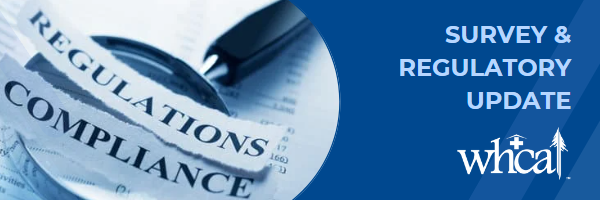Sept 29 2023 | Pharmacy Services-F758- Free from Unnecessary Psychotropic Medications/PRN Use
In 2017, the Centers for Medicare and Medicaid Services (CMS) expanded the category of antipsychotic medications to the new category of psychotropic medications. In doing so, CMS stated that a psychotropic medication is any drug that affects brain activities associated with mental processes and behavior. Examples of psychotropic medications include anti‐psychotics, anti‐depressants, anti‐anxiety medications, and hypnotics. CMS guidance indicates that “other” medications are also subject to same requirements if the use of the medication appears to be a substitution for another psychotropic medication. An example of this could be a seizure medication being used for a resident with no history of seizures. Changes to the regulations were made due to CMS concerns that the use of psychotropic medications could increase as nursing facilities decrease antipsychotics.
In the State Operations Manual (SOM), CMS added language to the guidance regarding investigating concerns and the side effects table which directs surveyors to evaluate if a resident has experienced psychosocial harm-related side effects of medications. Instructions guide surveyors to look at whether a resident has experienced the following:
- Side effects such as sedation, lethargy, agitation, mental status changes
- Behavior changes which may have affected the resident’s ability to perform activities of daily living
- Changes in how the resident interacts with others
- Resident withdrawal or decline from usual social patterns
- Decreased resident engagement in activities
- Resident change or diminished ability to think or concentrate
Additional areas of CMS focus include revisions to F755-Pharmacy Services-Fentanyl patches and F758-Free from Unnecessary Psychotropic Medications/PRN Use-gradual dose reductions, misdiagnosis, psychosocial harm, side effects.
At F755, CMS revised guidance on the disposal of used fentanyl patches. CMS stated that FDA instructions to fold the used patch and flush down the toilet are not always appropriate for nursing facilities. The US Environmental Protection Agency (EPA) does not currently ban flushing of pharmaceuticals unless they are considered hazardous, which fentanyl patches are not. However, state and local laws may restrict flushing of pharmaceuticals. CMS states the facility may use drug disposal systems for fentanyl patches if they can show that the system minimizes accidental exposure and diversion. Lastly, disposal of fentanyl patches in common areas or resident room trash cans or sharps containers would not be compliant as these methods do not prevent accidental exposure or diversion.
At F758, CMS added language to describe gradual dose reductions which states that dose reductions should occur in modest increments over adequate periods of time to minimize withdrawal symptoms and to monitor symptom recurrence. CMS added language to address situations where residents are potentially misdiagnosed with a condition for which antipsychotics are approved use, such as a new diagnosis of schizophrenia. This diagnosis excludes the resident from the long‐stay antipsychotic quality measure. When investigating a potential misdiagnosis, CMS directs surveyors to consider F658 to determine if the practitioner’s diagnosing practices meet professional standards, and F641 to determine if the facility completed an assessment which accurately reflects the resident’s status.
Lastly, CMS updated the deficiency categorization section of the Guidance to Surveyors to ensure the examples used show the appropriate severity level. Facilities should utilize the Critical Element Pathway to evaluate and audit their own compliance. Important areas to consider include ensuring that facility practices are in place to identify, evaluate, and intervene for potential or actual unnecessary medications and that there is a systematic process to evaluate the medication regimen review for each resident.
Helpful steps a facility can take to ensure compliance and operationalizing the CMS updates include:
❑ Examine existing policy and/or process on drug disposal of fentanyl patches to ensure it meets updated guidance. Educate staff on policy and any process changes related to disposal of fentanyl patches.
❑ Evaluate current antibiotic stewardship program to ensure use of infection assessment tools, monitoring of antibiotic use, and feedback and education to prescribers that unnecessary antibiotic use is not taking place.
❑ Identify residents currently receiving other medications (antihistamines, anti-cholinergic medications, and central nervous system agents) to ensure they are not prescribed off label or that use appears to be a substitute for an anti-psychotic, anti-depressant, anti-anxiety, or hypnotic. If identified for off label use, follow guidelines for psychotropic medication requirements.
❑ Review all residents who have a diagnosis of schizophrenia to ensure the medical record includes detailed evaluations by appropriate practitioners and relevant history consistent with professional standards.
❑ Review residents who receive a new active diagnosis of schizophrenia after admission to ensure residents’ medical records include detailed evaluations by appropriate practitioners, including documentation of persistent behaviors for the 6 months prior to the start of the antipsychotic medication in accordance with professional standards to ensure proper coding on the MDS. (Cross referenced with I6000 coding Schizophrenia on MDS) See MDS 3.0 RAI User’s Manual (v1.17.1R) Errata (v2) (cms.gov).
❑ Evaluate current policy and/or process related to gradual dose reductions to ensure they are occurring in increments outlined in guidance (two separate quarters with at least one month between the attempts), unless clinically contraindicated.
If you have questions regarding the SNF requirements, please contact Elena Madrid or call at (800) 562-6170, extension 105.
Posted in Skilled Nursing Facilities, Survey & Regulatory

